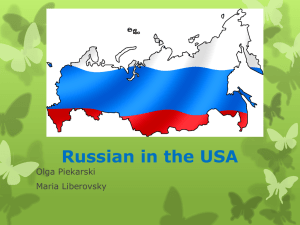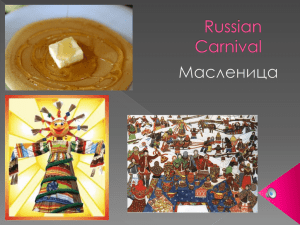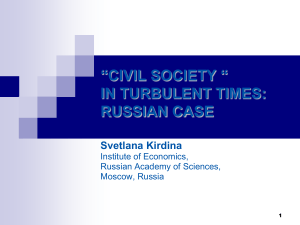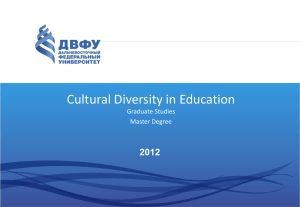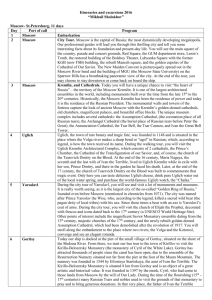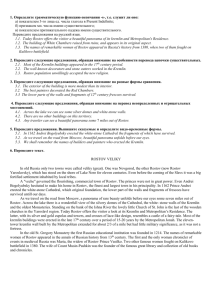UNESCO places in Russia - Oxford Heritage Travel
advertisement
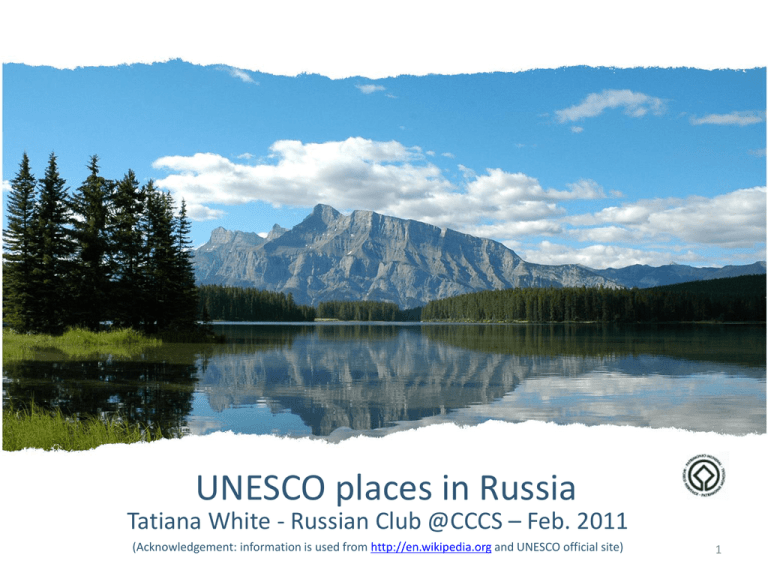
UNESCO places in Russia
Tatiana White - Russian Club @CCCS – Feb. 2011
(Acknowledgement: information is used from http://en.wikipedia.org and UNESCO official site)
1
2
Cultural
•
•
•
•
•
•
•
•
•
•
•
•
•
•
•
Architectural Ensemble of the Trinity Sergius Lavra in Sergiev Posad
(1993)
Church of the Ascension, Kolomenskoye (1994)
Citadel, Ancient City and Fortress Buildings of Derbent (2003)
Cultural and Historic Ensemble of the Solovetsky Islands (1992)
Curonian Spit (2000)
Ensemble of the Ferrapontov Monastery (2000)
Ensemble of the Novodevichy Convent (2004)
Historic and Architectural Complex of the Kazan Kremlin (2000)
Historic Centre of Saint Petersburg and Related Groups of Monuments
(1990)
Historic Monuments of Novgorod and Surroundings (1992)
Historical Centre of the City of Yaroslavl (2005)
Kizhi Pogost (1990)
Kremlin and Red Square, Moscow (1990)
Struve Geodetic Arc (2005)
White Monuments of Vladimir and Suzdal (1992)
3
Natural
•
•
•
•
•
•
•
•
•
Central Sikhote-Alin (2001)
Golden Mountains of Altai (1998)
Lake Baikal (1996)
Natural System of Wrangel Island Reserve (2004)
Putorana Plateau (2010)
Uvs Nuur Basin (2003)
Virgin Komi Forests (1995)
Volcanoes of Kamchatka (1996)
Western Caucasus (1999)
4
Cultural/Natural UNESCO sites (map from
Wikipedia site)
5
Architectural Ensemble of the Trinity
Sergius Lavra (XIV century)
The main church of the Lavra, the Cathedral of the Assumption
(echoing the Kremlin Cathedral of the same name), contains the
tomb of Boris Godunov. Among the treasures of the Lavra is the
famous icon, The Trinity, by Andrei Rublev.
The Trinity Lavra of St. Sergius (Russian: Тро́ице-Се́ргиева
Ла́вра) is the most important Russian monastery and the
spiritual centre of the Russian Orthodox Church. The
monastery
is situated in the town of Sergiyev Posad,
about 70 km to the
north-east from Moscow by the road
leading to Yaroslavl, and
currently is home to over 300 monks.
6
The Church of the Ascension (XVI
century)
The Church of the Ascension was built in 1532 on the imperial estate of
Kolomenskoye, near Moscow, to celebrate the birth of the prince who was
to become Tsar Ivan IV ('the Terrible'). One of the earliest examples of a
traditional wooden tent-roofed church on a stone and brick substructure,
it had a great influence on the development of Russian ecclesiastical
architecture.
Wooden palace in Kolomenskoe. 18th century picture.
7
Citadel, Ancient City and Fortress
Buildings of Derbent (VI Century)
The Citadel, Ancient City and Fortress Buildings of Derbent were part of
the northern lines of the Sasanian Persian Empire, which extended east
and west of the Caspian Sea. The fortification was built in stone. It
consisted of two parallel walls that formed a barrier from the seashore up
to the mountain. The town of Derbent was built between these two walls,
and has retained part of its medieval fabric. The site continued to be of
great strategic importance until the 19th century.
Often identified with the legendary
Gates of Alexander, Derbent claims
to be the oldest city in Russia.
Over the years different nations gave the city
different names, but all connected to the
word 'gate'.
8
Ensemble of the Ferapontov
Monastery (XIV Century)
The Ferapontov Monastery, in the Vologda region in northern Russia, is an
exceptionally well-preserved and complete example of a Russian Orthodox
monastic complex of the 15th-17th centuries, a period of great
significance in the development of the unified Russian state and its
culture. The architecture of the monastery is outstanding in its
inventiveness and purity. The interior is graced by the magnificent wall
paintings of Dionisy, the greatest Russian artist of the end
of the 15th century.
Location: Vologda Oblast
9
Ensemble of the Novodevichy
Convent (XVI Century)
The Novodevichy Convent, in south-western Moscow, built in the (16-17c)
in the so-called Moscow Baroque style, was part of a chain of monastic
ensembles that were integrated into the defence system of the city. The
Novodevichy Convent was founded in 1524 by Grand Prince Vasili III in
commemoration of the conquest of Smolensk in 1514. It was built as a
fortress at a curve of the Moskva River and became an important part of
the southern defensive belt of the capital, which had already included a
number of other monasteries. Ivan the Terrible later granted a number of
villages to the convent. The Novodevichy Convent was known to have
sheltered many ladies from the Russian royal
families and boyar clans, who had been forced
to take the veil, such as Feodor I's wife
Irina Godunova (she was there with her
brother Boris Godunov until he became a
10
ruler himself).
Historic and Architectural Complex of
the Kazan Kremlin (XVI-XIX Century)
Built on an ancient site, the Kazan Kremlin dates from the Muslim period
of the Golden Horde and the Kazan Khanate. It was conquered by Ivan the
Terrible in 1552 and became the Christian See of the Volga Land.
The Kazan Kremlin includes many old buildings, the oldest of which is
the Annunciation Cathedral (1554-62), the only 16th-century Russian
church to have six piers and five apses. Like many of Kazan's buildings of
the period, it is constructed of local pale sandstone rather than of brick.
The renowned Pskov architects Postnik Yakovlev and Ivan Shirjay (called
Barma) were invited by the Tzar to rebuild Kazan Kremlin in stone.
11
Historic Centre of St. Petersburg and
Related Groups of Monuments (XVIIIXIX Century)
The 'Venice of the North', with its numerous canals and more than 400
bridges, is the result of a vast urban project begun in 1703 under Peter
the Great. It was the capital of the Russian Empire for more than two
hundred years (1713–1728, 1732–1918). St. Petersburg ceased being the
capital in 1918 after the Russian Revolution of 1917. It is Russia's second
largest city after Moscow with 4.6 million inhabitants. St. Petersburg is a
major European cultural centre also was known as Leningrad (in the
former USSR). Its architectural heritage reconciles the very different
Baroque and pure neoclassical styles, as can be seen in the Admiralty,
the Winter Palace, the Marble Palace and the Hermitage.
12
Historic Centre of the City of Yaroslavl
(XVI Century)
Situated at the confluence of the Volga and Kotorosl Rivers some 250 km
north-east of Moscow, the historic city of Yaroslavl developed into a
major commercial centre from the 11th century. It is renowned for its
numerous 17th-century churches and is an outstanding example of the
urban planning reform Empress Catherine the Great ordered for the
whole of Russia in 1763. While keeping some of its significant historic
structures, the town was renovated in the neoclassical style on a radial
urban master plan. It has also kept elements from the 16th century in
the Spassky Monastery, one of the oldest in the
Upper Volga region, built on the site of a
pagan temple in the late 12th century
but reconstructed over time.
13
Kizhi Pogost (XVIII-XIX Century)
Situated on the ancient trade route between Central Asia and northern
Europe, Novgorod was Russia's first capital in the 9th century.
Surrounded by churches and monasteries, it was a centre for Orthodox
spirituality as well as Russian architecture. Its medieval monuments and
the 14th-century frescoes of Theophanes the Greek (Andrei Rublev's
teacher) illustrate the development of its remarkable architecture and
cultural creativity.
According to the Russian
carpentry traditions of
that time, the
Transfiguration Church
was built of wood only
with no nails.
14
Moscow Kremlin and Red Square (XIIIXX Century)
Moscow (the capital of Russia) linked to all the most important historical
and political events in Russia since the 13th century, the Kremlin (built
between the 14th and 17th centuries by outstanding Russian and foreign
architects) was the residence of the Great Prince and also a religious
centre.
At the foot of its ramparts,
on Red Square, St Basil's
Basilica is one of the most
beautiful Russian
Orthodox monuments.
15
Cultural and Historic Ensemble of the
Solovetsky Islands (XV Century)
The Solovetsky archipelago comprises six islands in the western part of
the White Sea, covering 300 km2. They have been inhabited since the
5th century B.C. and important traces of a human presence from as far
back as the 5th millennium B.C. can be found there. The archipelago has
been the site of fervent monastic activity since the 15th century, and
there are several churches dating from the 16th to the 19th century.
"Bombardment of
the Solovetsky
Monastery by the
Royal Navy during
the Crimean War".
16
Struve Geodetic Arc (XIX Century)
The Struve Arc is a chain of survey triangulations
stretching from Hammerfest in Norway to the
Black Sea, through 10 countries and over 2,820
km. These are points of a survey, carried out
between 1816 and 1855 by the astronomer
Friedrich Georg Wilhelm Struve, which
represented the first accurate measuring of a
long segment of a meridian. This helped to
establish the exact size and shape of the planet and marked an
important step in the development of earth sciences and topographic
mapping. It is an extraordinary example of scientific collaboration among
scientists from different countries, and of collaboration between
monarchs for a scientific cause. The original arc consisted of 258 main
triangles with 265 main station points. The listed site includes 34 of the
original station points, with different markings, i.e. a drilled hole in rock,
iron cross, cairns, or built obelisks (Location: Leningradskaya Oblast’)
17
White Monuments of Vladimir and
Suzdal (XII-XIII Century)
These two artistic centres in central Russia hold an
important place in the country's architectural history.
There are a number of magnificent 12th- and 13thcentury public and religious buildings, above all the masterpieces of the
Collegiate Church of St Demetrios and the Cathedral of the Assumption of the
Virgin.
Vladimir-Suzdal Rus’ (Russian: Владимирско-Су́здальская Русь,
Vladimirsko-Suzdal'skaya Rus’) was one of the major principalities which
succeeded Kievan Rus' in the late 12th century and lasted until the late
14th century. For a long time the Principality was a vassal of the
Mongolian Golden Horde. Traditionally, it is perceived as a cradle of the
Great Russian language and nationality, Vladimir-Suzdal gradually
evolved into the Grand Duchy of Moscow.
18





